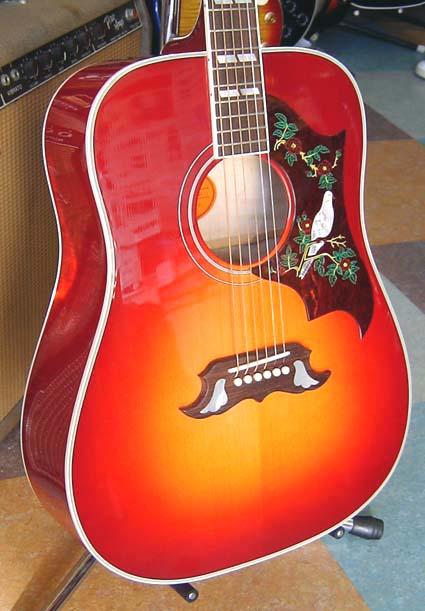 |
| TV Jones Spectrasonic |
The goal was to build a guitar that could be created in quantity, but maintain quality. The result was the Spectrasonic Lead guitar, the Spectrasonic bass and the Spectrasonic C Melody guitar.
This guitar was originally designed with Brian Setzer in mind, however other artists have made this instrument part of their collection.
| Getsch Spectrasonic |
Noel Gallahger, the Edge of U2, John Fogarty and the Reverend Horton Heat all own the Spectrasonic.
| Gretsch Spectrasonic |
Many Spectrasonic players seem to prefer the Japanese made instrument. Two companies manufactured them; Fujigen gakki which has been in business in Matsumoku, Japan since 1960 and Terada which started in 1912 in Nagoya, Japan.
Gretsch production ended in 2005. The US models are said to have a slightly wider neck.
The guitars standard colour was black with a large white pickguard. It features 2 TV Jones Alnico PowerTron Humbucking pickups.
 |
| Gretsch Spectrasonic G6143 |
The fingerboard is made of African padauk wood and is topped with 22 frets and pearloid dot inlays. The Gretsch logo is inlaid on the headstock. The 15.25 inch body is bound. The body is 1.875 inches deep. The neck has position markers on the side.
The bridge saddle is an adjusto-matic, which is Gretsch's answer to the tune-o-matic bridge. The strings are held in place with a chrome Bigsby B-12 Vibrato tailpiece. At the other end of the neck are chromed tuning key and an adjustable truss rod. The guitar joins the neck at the 16th fret.
The controls consist of one volume and one tone knob on the guitars lower bout and a selector switch on the top bout.
The accouterments are similar to the Spectrasonic guitar. All of the models excetpt the bass feature Bigsby is a B-12 model tremolo. The longer neck on the C Melody is 29.25 inch scale.
The Spectra Sonic bass guitar has all of the features of the first two models, but the 4 string 33 inch scale neck joins the body at the 15th fret.
When Gretsch's licensing agreement ended Spectrasonic manufacturing was taken over by TV Jones. Some changes have been made and the guitar is now called the Spectrasonic Supreme to distinguish the upgrades.
The finish is available in either charcoal black with a laminated flamed maple top or translucent cherry red, also with a figured maple top. The guitar undergoes a nitro-cellulose lacquer finish process.
The pickups are TV Jones Classic humbuckers which have more low end than Powertrons. The same Bigsby Vibrato adorns the lower bout. The neck inlay features what Mr. Jones calls, Shoe-string potato fret markers.
This instrument comes with Sperzel non-locking tuners, manufactued in Cleveland Ohio. The fingerboard on this instrument is made of ebony and adorned with what Jones refers to as pearloid
The neck has a 12" radius. The entire instrument is bound including the head-stock.The body is bound with w/b/w/b trim.
The wiring harness, 500K potentiometers (tone has a .022uf capacitor) and selector switch are all made by Switchcraft. The knobs and switch cover are all made of aluminum. The white/black/white pickguard almost looks like part of the body.
The 1.68 inch nut is made of a material called Delrin, which is slippery and prevents the strings from locking up, which not only aids with the Bigsby, but helps maintain tonality. The adjustable bridge saddle is a Gotoh ABR-1 model.
All Spectrasonics are set up by Mr. Jones before leaving his facility. He inspects each guitar, matches the fingerboard and bridge radius and cuts the nut slots himself. Incredible!!
Plans are in the works to manufacturer the Spectrasonic Supreme C Melody guitar and Spectronsonic Supreme Bass.
TV Jones.com























